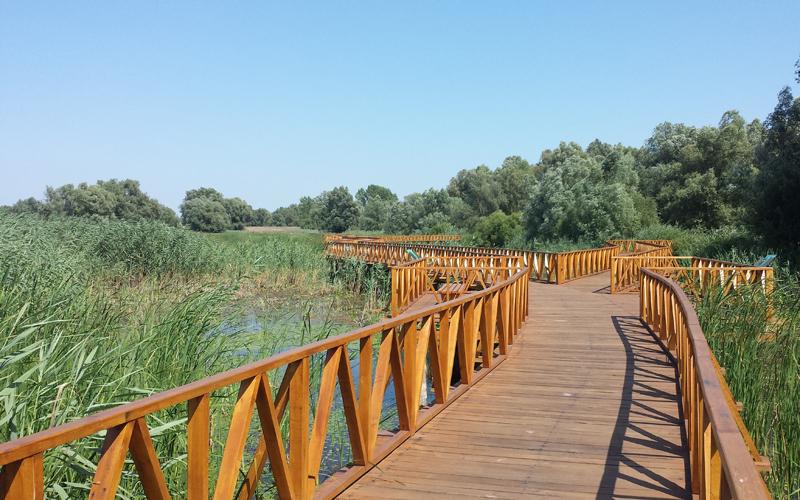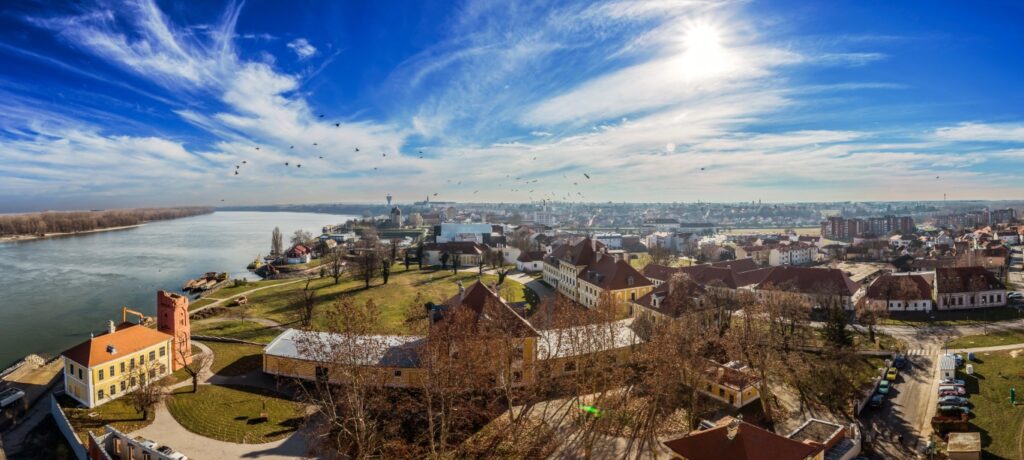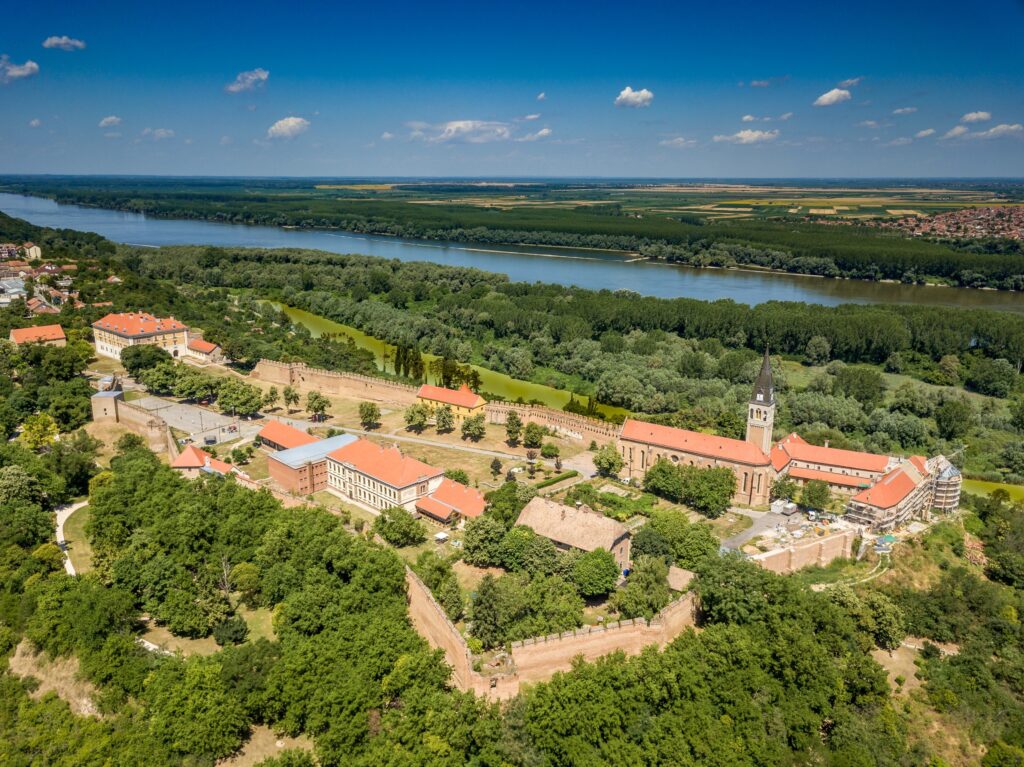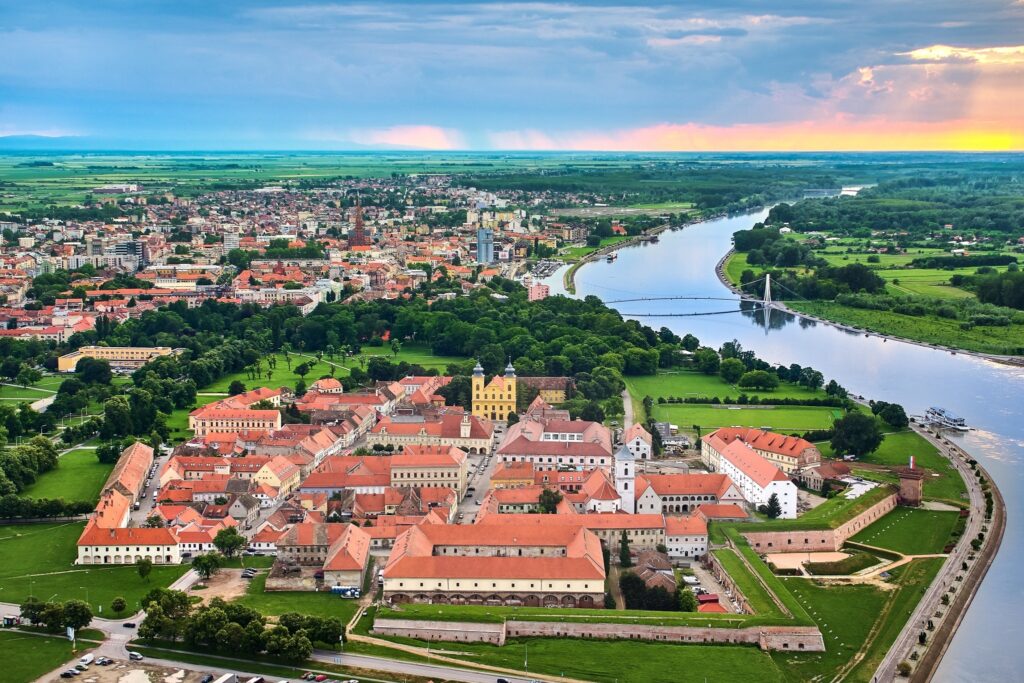Slavonia sits in eastern Croatia. Planning is simple. The region stretches from the Drava to the Sava and the Danube. Expect space, quiet roads, and warm hosts. Rivers frame wetlands. Low hills hold forests and vineyards. Baroque towns add history and café life. Plan a slow loop: Osijek → Kopački Rit → Vukovar → Ilok → Kutjevo/Požega → Papuk.

Table of Contents
ToggleOrientation
Slavonia is one of Croatia’s historic regions, covering five counties: Osijek‑Baranja, Požega‑Slavonia, Virovitica‑Podravina, Brod‑Posavina, and Vukovar‑Srijem. Osijek, the main city on the Drava, sits south of Baranja (the wetland‑rich wedge between the Drava and Danube). The Danube shapes the east near Vukovar and Ilok, the Sava borders the south near Slavonski Brod, and Papuk rises above the plains near Požega and Kutjevo. From Zagreb, allow about 2.5–3 hours by car to Osijek, depending on traffic.
Key names you will meet:
Osijek – regional hub with the Baroque Tvrđa.
Kopački Rit Nature Park – major wetland at the Danube–Drava confluence.
Papuk Nature Park – a UNESCO Global Geopark with beech woods and waterfalls.
Đakovo – cathedral town and home to a Lipizzaner stud.
Vukovar – Danube city with museums and memorial sites.
Ilok – wine town above the Danube with famed Traminac.
Kutjevo – historic cellars and Graševina vineyards.
Slavonski Brod – Sava river city with a large star‑fortress.
Vinkovci – lively in September during Autumns (Vinkovačke jeseni).
Why visit Slavonia
Space and calm
Roads are quiet. Villages feel authentic. You move without stress. Sunrises over fields are wide and soft.
Nature at your door
Wetlands teem with birds. Forests offer shade. Hills add viewpoint walks. Rivers invite cycling and slow days.
Culture with depth
Baroque streets, fortresses, and museums tell Central European stories. Festivals bring folk dress and music. Food is hearty. Wine is strong in character.
Value for money
Accommodation is fairly priced. Meals are generous. Tastings are accessible. You can splurge on experiences without breaking the budget.
Best time to visit
Spring (April–June): Mild days. Migratory birds. Vineyards green. Festivals start.
Summer (July–August): Warm on the plains. Long evenings by rivers. Festivals peak. Book stays with air‑conditioning.
Autumn (September–October): Harvest time. Golden fields. Clear hiking days. Wine events in villages.
Winter (November–March): Quiet museums. Frosty walks. Advent lights in towns. Good for slow weekends.
Tip: Wetland water levels change. Spring and autumn often give the best boat tours and birdwatching.
Getting there
From Zagreb: A3/E70 motorway runs east to Slavonski Brod and beyond. Expect around 2–3 hours to Osijek via main roads.
From Hungary or Serbia: Border crossings lead to Osijek, Vukovar, and Ilok regions. Roads are direct.
By train or bus: Zagreb–Osijek trains/buses typically take 3–4 hours; Zagreb–Vinkovci is similar. Weekend and holiday timetables can be thinner—check morning/evening departures in advance. Regional buses connect county seats and larger towns.
Getting around
Car: Best flexibility for villages, vineyards, and nature parks.
Bike: The Danube Cycle Route (EuroVelo 6) follows the Croatian Danube for roughly 150 km, linking Baranja/Osijek, Vukovar, and Ilok. River sections are gentle and scenic.
Local transport: Buses link main towns. Timetables are thinner on weekends and holidays. Plan ahead.
Top things to do in Slavonia
2) Wander Osijek’s Tvrđa
Explore the Baroque fortress quarter. Streets line up in a neat grid. Cafés fill old houses. The Drava promenade is a short walk away. Visit museums, then watch sunset on pedestrian bridges.
1) Boat through Kopački Rit Nature Park
This is one of Europe’s great alluvial wetlands. Look for herons, egrets, and white‑tailed eagles. Boardwalks and hides bring you close. Typical boat tours last 60–90 minutes when levels allow. Boat operations depend on water levels. Spring and autumn shine.
3) Hike Papuk Nature Park (UNESCO Global Geopark)
Beech forests keep you cool. Jankovac Forest Park offers lakes and waterfalls. Trails suit families and casual hikers. Geology points explain ancient rocks and volcanic history.
4) Tour Đakovo Cathedral and meet the Lipizzaners
The red‑brick cathedral dominates the square. Interiors echo with light. The state stud farm keeps elegant horses. Riding displays are held on selected days.
5) Follow the Danube on two wheels
Ride EuroVelo 6 along levees and quiet lanes. Stages link Osijek, Vukovar, and Ilok. Pack water in summer. Mornings and late afternoons are best.
6) Taste wine in Ilok and Kutjevo
Ilok is famous for Traminac. Tastings often come with Danube views. Kutjevo is the heartland of Graševina. Historic cellars add atmosphere. Book a driver or stay overnight.
7) Step into Vukovar’s riverside heritage
Walk the promenade. Visit museums that present the city’s story. Add the Vučedol Culture Museum nearby. End with a Danube sunset.
8) Explore the star‑plan Brod Fortress
Slavonski Brod guards the Sava. Bastions spread in a striking pattern. The grounds suit long, easy strolls. Families enjoy the space.
9) Time your trip for festivals
Đakovački vezovi brings folklore in late June or July. Vinkovci Autumns fills September with costumes and music. Local food stands and parades create a festive mood.
10) Slow down in Stara Kapela
This small ethno village preserves timber houses and village life. It makes a peaceful base for walks and rustic meals.
Osijek: river city with Baroque bones
Osijek is the region’s cultural hub. The Tvrđa is the star. Streets in the old grid host cafés, galleries, and student hangouts. The Drava promenade links bridges and parks. Modern neighborhoods add murals and street art.
What to do
Explore the Tvrđa on foot.
Visit the Museum of Slavonia and nearby galleries.
Cross the pedestrian bridge at sunset.
Cycle the river path. Join EV6 east or west.
Book a day trip to Kopački Rit or Baranja villages.
Food and drink
Expect generous plates. Try fish paprikash, čobanac stew, and grilled river fish. Local craft beer is growing. Cafés serve strong coffee and cakes.
Good for
First‑time visitors, city breaks, and families. The layout is walkable. Day trips are easy.
Kopački Rit Nature Park: life at the confluence
The park sits where the Drava meets the Danube. Channels, lakes, and reedbeds create rich habitats. Birds thrive year‑round. Spring migration is dramatic. Summer water lilies fill quiet pools. Autumn colors glow on willows and poplars.
What to do
Join a guided boat tour when water levels allow.
Walk the boardwalks to hides.
Bring binoculars and patience.
Combine with a Baranja lunch in a nearby village.
Tips
Wear insect repellent in summer. Respect closures during high water. Early morning brings the most birds.

Papuk Nature Park: a UNESCO Global Geopark (since 2007)
Papuk rises above fields to the west of Požega. Forest roads lead to trailheads and picnic areas. The Jankovac area is the most popular. Waterfalls, lakes, and shaded paths suit all ages.
What to do
Hike the Jankovac lake loop.
Stop at geology points.
Seek viewpoints above the beech canopy.
Picnic by the water.
Tips
Weather changes fast on hills. Carry layers and water. Marked trails are clear but bring a map for longer walks.
Đakovo: cathedral town with horses
Đakovo centers on its proud cathedral. Red brick and twin towers rise above rooftops. Inside, frescoes and light create a calm mood. The state stud farm keeps Lipizzaner horses. Parades and riding shows feature at times.
What to do
Tour the cathedral.
Visit the stud farm.
Plan for Đakovački vezovi if traveling in early summer.
Good for
Architecture lovers and families. The town is compact and friendly.

Vukovar: river views and layered history
Vukovar sits on a handsome Danube bend. The riverfront is open and green. Museums trace the city’s complex story. The Vučedol Culture Museum lies a short drive away. Cafés line the promenade.
What to do
Walk the Danube promenade.
Visit key museums and memorials.
Add Vučedol Culture Museum to the day.
Cycle a stretch of EuroVelo 6.
Good for
Travelers who like history, wide rivers, and quiet streets.

Ilok: wine town above the Danube
Ilok crowns the far east of Croatia. Vineyards wrap the hills. The medieval core holds cellars and tasting rooms. Traminac is the signature wine. Danube views stretch to Serbia and beyond. The Principovac estate sits above the vineyards.
What to do
Taste Traminac and Graševina.
Tour the old cellars.
Walk the medieval streets and ramparts.
Watch sunset over the river.
Tips
Book tastings in advance. Arrange a driver if touring several wineries.

Kutjevo and Požega: heart of Graševina
Kutjevo is a classic wine village. Historic cellars date back centuries. Graševina shows many styles here. Požega is the nearby town with squares and cafés. Papuk trailheads sit within easy reach.
What to do
Explore Kutjevo’s wine roads.
Visit an old cellar and compare vintages.
Add a Papuk hike for a balanced day.
Good for
Wine lovers who enjoy quiet villages and gentle hills.
Slavonski Brod: a fortress on the Sava
Slavonski Brod shares the Sava with Bosnia and Herzegovina across the river. The star‑shaped fortress is the headline sight. Parks and paths make riverside time easy. Families will find space to play and ride.
What to do
Walk the bastions and courtyards.
Explore the riverfront paths.
Visit house museums linked to local authors.
Good for
Travelers on the A3 corridor who want a cultural stop with room to move.
Vinkovci: living tradition in early autumn
Vinkovci is a key node on the plains. The town hosts Vinkovačke jeseni each September. Folklore groups fill streets with music and dance. Crafts and food stands add to the mood.
What to do
Time a visit for festival dates if you can.
Explore the center on foot.
Combine with Vukovar or Đakovo in a one‑day loop.
Wine and food
Grapes to know
Graševina: Fresh and food‑friendly. Dry versions pair with river fish and salads. Late‑harvest bottles reward patient sipping.
Traminac (Traminer): Ilok’s signature. Aromatic, floral, and expressive.
Frankovka (Blaufränkisch): Red to look for in warmer sites.
Where to taste
Ilok: Old cellars and hilltop estates with Danube views.
Kutjevo: Historic producers and family wineries along local roads.
Feričanci and Baranja: Growing scenes with characterful reds and whites.
Plates to try
Fish paprikash from river kitchens.
Čobanac meat stew with paprika.
Kulen sausage, sliced thick.
Strudels and cakes with coffee after walks.
Tip: Book a designated driver for tasting days. Rural taxis exist but need arranging.
Nature and outdoors
Wetland days in Kopački Rit
Best seasons: spring and autumn. Typical visit: two to four hours. Start early for soft light and active birds. Join a guided boat tour when levels allow; trips usually last 60–90 minutes. Walk the boardwalks and pause at hides. Expect herons, egrets, spoonbills, black storks, and white‑tailed eagles. Paths are flat and stroller‑friendly. Bring binoculars. Pack water, a hat, and repellent in summer. Respect closures during high water and nesting. Drones are usually not allowed.
Easy plan: Boat tour → boardwalk loop → lunch in a Baranja village.
Forest walks in Papuk
Head for Jankovac Forest Park. The lake loop runs 3–6 km with spurs to waterfalls. Trails are well marked and shaded. October brings peak color across beech woods. Winter walks feel crisp and calm. Phone signal can drop in valleys. Wear layers and grippy shoes. Carry a paper map for longer routes. Mountain huts often open on weekends.
Easy plan: Jankovac lake loop → waterfall view → picnic by the water.
Cycling the rivers
EuroVelo 6 follows the Danube and Drava. Roads are mostly flat with levee sections. Surfaces vary from asphalt to firm gravel. Avoid unpaved levees after heavy rain. Wind rises in the afternoon; plan returns with a tailwind. Carry tools, spare tubes, and lights. Refill water at towns and petrol stations.
Day‑ride ideas:
Osijek → Vukovar: 50–60 km. River views and quiet lanes.
Vukovar → Ilok: 35–40 km. Danube bends and vineyard edges.
Osijek → Baranja villages loop: 25–45 km. Farms, wetlands, and storks.
Safety tips: Yield to farm vehicles on levees. Keep right on narrow paths. Use lights in low visibility.

Where to stay in Slavonia
Choose your base by interest and pace.
Osijek: Best first base. Cafés, nightlife, museums. Easy access to Kopački Rit.
Ilok or Kutjevo: Ideal for wine weekends. Views, tastings, quiet nights.
Vukovar: Good for Danube walks and EV6 stages.
Slavonski Brod: Handy on the A3. Space for families. Big fortress to explore.
Rural villages: Try Baranja or Stara Kapela for heritage stays and slow mornings.
Booking tips
Check for air‑conditioning in summer and heating in winter. Ask about bike storage if cycling. Look for on‑site parking in villages and small towns.
Suggested itineraries
Three days: Osijek and the wetlands
Day 1: Arrive in Osijek. Walk the Tvrđa. Dinner near the walls.
Day 2: Kopački Rit boat tour and boardwalks. Lunch in a Baranja village. Evening on the Drava promenade.
Day 3: Cycle a short EV6 section. Museum time in the afternoon. Café crawl at sunset.
Five days: Add wine and hills
Day 1–3: As above in Osijek and Kopački Rit.
Day 4: Drive to Kutjevo and Požega. Cellar visit and tasting. Short Papuk hike in Jankovac.
Day 5: Continue to Slavonski Brod. Walk the fortress. Return or stay the night.
Seven days: The Danube loop
Day 1–2: Osijek base, Tvrđa, and Kopački Rit.
Day 3: Vukovar for river views and museums.
Day 4–5: Ilok for Traminac and Danube sunsets. Cycle a quiet EV6 stretch.
Day 6: Kutjevo or Požega. Taste Graševina. Add a Papuk walk.
Day 7: Slavonski Brod fortress and Sava paths. Drive out on the A3.
Practical tips
Cash and cards: Cards work in towns. Carry some cash for villages and small events.
Driving: Watch for tractors and harvest traffic in autumn. Fuel stations are regular on main roads.
Language: English is common in cities. In villages, smiles and simple phrases go far.
Weather: Summers are warm. Winters can be cold and foggy. Check forecasts for wetlands and hills.
Packing: Binoculars for Kopački Rit. Light layers for Papuk. Reusable bottle for car days.
Events and seasonality
Đakovački vezovi (late June–July): Folklore parades and Lipizzaner displays.
Vinkovci Autumns (September): Costumes, dances, street music, crafts.
Vukovar Film Festival (late summer): Screenings by the Danube.
Dates can shift. Check schedules closer to your trip. Plan stays early for festival weekends.
Responsible travel
Stay on marked paths in wetlands and forests.
Respect wildlife and nesting seasons.
Support small cellars and farms with tastings and purchases.
Use refillable bottles and sort waste in towns that provide bins.
FAQs
Is Slavonia part of Croatia? Yes. It is the country’s eastern region, spread across five counties.
What is Slavonia best known for? Nature, wine, and Baroque towns. Kopački Rit and Papuk stand out. Osijek’s Tvrđa and river promenades do too.
Do I need a car? It helps. Towns are walkable, but villages and parks are scattered. Cycling works along rivers. Buses connect main centers with limited frequency.
Can I cycle the Danube in Croatia? Yes. EuroVelo 6 links Osijek, Vukovar, and Ilok. Terrain is mostly gentle. Surfaces vary. Plan daily distances for weather and wind.
Which wines should I try? Graševina from Kutjevo and Traminac from Ilok. Also look for Frankovka and blends from Baranja and Feričanci.
How many days should I plan? Three days cover Osijek and Kopački Rit. Five add wine and Papuk. A week enables a Danube loop with Ilok and Vukovar.
Is Slavonia good for families? Yes. Fortresses, parks, and rivers make easy days. Choose stays with parking and outdoor space.
Is winter a bad time? No. It is quiet and cold but calm. Museums stay open. Wetland scenes are atmospheric. Pack warm layers.
Plan your Slavonia trip
Pick one headline experience to anchor your days. Add a Danube tasting in Ilok and a Kopački Rit morning by boat. Leave time for a Papuk walk and a slow evening in Osijek’s Tvrđa. Take the plains at an easy pace.
Discover Slavonia: Cities, Villages, Posts & Nature
Disclosure: This page may contain affiliate links. This means that we get a small commission from any purchase you make, at no additional cost to you!
